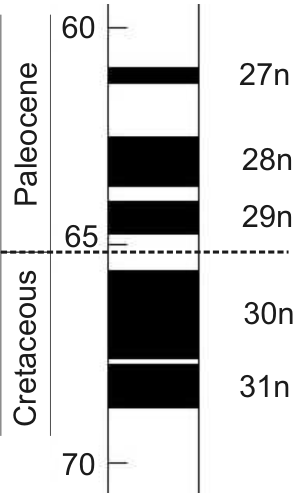John has brought this rather entertainingly-titled abstract to my attention:
Fassett, J.E. 2007. The documentation of in-place dinosaur fossils in the Paleocene Ojo Alamo Sandstone and Animas Formation in the San Juan Basin of New Mexico and Colorado mandates a paradigm shift: dinosaurs can no longer be thought of as absolute index fossils for end-Cretaceous strata in the Western Interior of North America. New Mexico Geology 29(2):56.
If you follow the link, this is actually found under the abstracts for the New Mexico Geological Society Spring Meeting (pdf), and the first paragraph reads thus:
Extensive geochronologic studies of the rocks adjacent to the Cretaceous-Tertiary (K-T) interface in the San Juan Basin have now provided compelling data attesting to the Paleocene age of the dinosaur-bearing Ojo Alamo Sandstone in New Mexico and the Animas Formation in Colorado. These data consist of radiometric age determinations for Cretaceous strata underlying the K-T interface and palynologic, paleomagnetic, and geochemical evidence attesting to the Paleocene age of the strata above the K-T interface. The identification of the paleomagnetic normal interval – C29n – in the dinosaur-bearing lower part of the Ojo Alamo Sandstone in the southern San Juan Basin at multiple localities allows for the precise dating of the last occurrence of Paleocene dinosaurs at the top of chron C29n at 64.432 Ma.
Head over to Evolving Thoughts for a discussion of the second paragraph, which fulfils the promise of the title with liberal use of the terms “conventional wisdom”, “entrenched dogma”, and “paradigm”. The tone is interesting given that, assuming the data are good, the interpretation is straightforward. Here’s the sequence of magnetic reversals over the KT boundary (black is normal polarity, white is reversed – a link for the confused):

As you can see, the KT boundary sits in a period of reversed polarity, but for a few million years either side of that the field was mostly normal polarity. Therefore, if you have a sedimentary formation which goes from reversed polarity magnetizations to normal polarity magnetizations, associated with rocks which have been dated as 65 million years old, you can be pretty certain you’re looking at chron 29n (‘chron’ being the technical term for a period of stable magnetic polarity), and the rocks are Paleocene. Indeed, a Paleocene age for the Ojo Alamo sandstone does not seem to be controversial anyway, since it seems to form an erosional boundary with late Cretaceous sediments, and the iridium anomaly which defines the KT boundary itself seems to be part of the missing sequence. Plus, who would dare to disagree with Steve Steve?.
Illumination is provided by Brian of Laelaps: the question is not over the age of the rocks, but the age of the dinosaur bones found within them:
While I am no expert on the subject and could very well have missed some finds, most of the alleged fossils are bone fragments and teeth (teeth being especially durable), fossils that easily could be exhumed and reburied (=”reworked.” “Transport” means travelling some distance away from the original site and only sometimes is such material reworked) in Paleocene deposits (thus being buried with Paleocene-age pollen). To the best of my understanding, there are no Paleocene dinosaur tracks, no articulated Paleocene dinosaur skeletons (which means there was little disturbance/no reworking), no Paleocene dinosaur skulls, no Paleocene dinosaur nests, or anything that would absolutely rule out reworking in some form or another.
In other words, this ‘proof’ is somewhat missing the point of the arguments against Paleocene dinosaurs – and given that erosional boundary with the Cretaceous, it is entirely possible that reworking could explain the fossilised dinosaur material within the lowest part of the Ojo Alamo. Also, we’re talking about a single bone here. One bone. So this stunning paradigm shift moves us from “The KT extinction event killed off the dinosaurs” to “The KT extinction event killed off 99.9999% of the dinosaurs.” Throw away those paleontology textbooks, people!
For those who want to read more and have paid their dues to New Scientist, it seems that they have an article up about the claims of Fassett and others.



Comments (4)